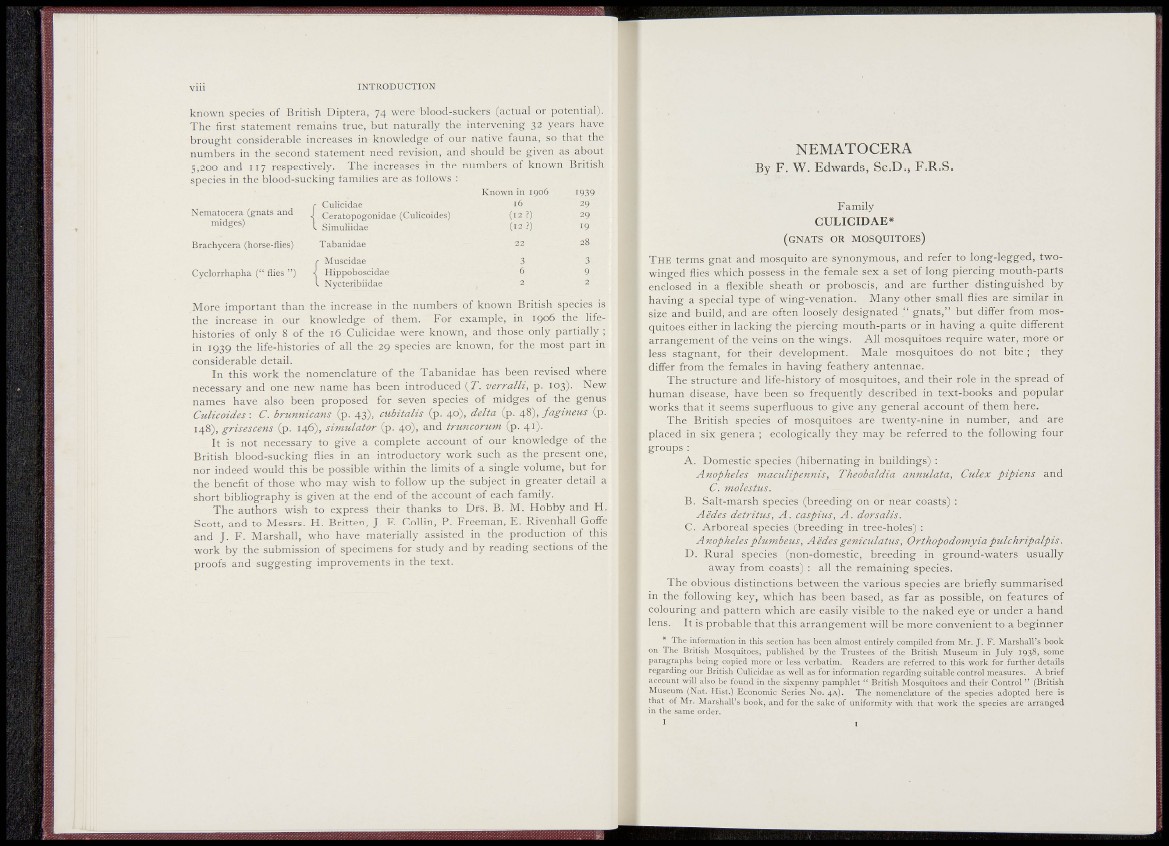
vili I N T R O D U C T I O N
known species of British Diptera, 74 were blood-suckers (actual or potential).
The first statement remains true, but naturally the intervening 32 years have
brought considerable increases in knowledge of our native fauna, so that the
numbers in the second statement need revision, and should be given as about
5,200 and 117 respectively. The increases in the numbers of known British
species in the blood-sucking families are as follows :
Nematocera (gnats and
midges)
Brachycera (horse-flies)
Cyclorrhapha (" flies ")
Culicidae
Ceratopogonidae (Culicoides)
Simuliidae
Tabanidae
Muscidae
Hippoboscidae
Nycteribiidae
Known in 190Ó 1939
16 29
(12?) 29
(12?) 19
22 28
3 3
6 9
2 2
More important than the increase in the numbers of known British species is
the increase in our knowledge of them. For example, in 1906 the lifehistories
of only 8 of the 16 Culicidae were known, and those only partially ;
in 1939 the life-histories of all the 29 species are known, for the most part in
considerable detail.
In this work the nomenclature of the Tabanidae has been revised where
necessary and one new name has been introduced {T. verralli, p. 103). New
names have also been proposed for seven species of midges of the genus
Culicoides : C. brunnicans (p. 43), cubitalis (p. 40), delta (p. 48), fagineus (p.
148), grisescens (p. 146), simulator (p. 40), and truncorum (p. 41).
It is not necessary to give a complete account of our knowledge of the
British blood-sucking fiies in an introductory work such as the present one,
nor indeed would this be possible within the limits of a single volume, but for
the benefit of those who may wish to follow up the subject in greater detail a
short bibliography is given at the end of the account of each family.
The authors wish to express their thanks to Drs. B. M. Hobby and H.
Scott, and to Messrs. H. Britten, J. E. Collin, P. Freeman, E. Rivenhall Goffe
and J. F. Marshall, who have materially assisted in the production of this
work by the submission of specimens for study and by reading sections of the
proofs and suggesting improvements in the text.
NEMATOCERA
By F. W. Edwards, Sc.D., F.R.S.
Family
CULICIDAE*
(GNATS OR MOSQUITOES)
THE terms gnat and mosquito are synonymous, and refer to long-legged, twowinged
flies which possess in the female sex a set of long piercing mouth-parts
enclosed in a flexible sheath or proboscis, and are further distinguished by
having a special type of wing-venation. Many other small flies are similar in
size and build, and are often loosely designated " gnats," but differ from mosquitoes
either in lacking the piercing mouth-parts or in having a quite different
arrangement of the veins on the wings. All mosquitoes require water, more or
less stagnant, for their development. Male mosquitoes do not bite ; they
differ from the females in having feathery antennae.
The structure and life-history of mosquitoes, and their role in the spread of
human disease, have been so frequently described in text-books and popular
works that it seems superfluous to give any general account of them here.
The British species of mosquitoes are twenty-nine in number, and are
placed in six genera ; ecologically they may be referred to the following four
groups :
A. Domestic species (hibernating in buildings) :
Anopheles maculipennis, Theobaldia annulata, Culex pipiens and
C. molestus.
B. Salt-marsh species (breeding on or near coasts) :
Aedes detritus, A. caspius, A. dorsalis.
C. Arboreal species (breeding in tree-holes) :
A nopheles phimbeus, A edes geniculatus, Orthopodoniyia pulchripalpis.
D. Rural species (non-domestic, breeding in ground-waters usually
away from coasts) : all the remaining species.
The obvious distinctions between the various species are briefly summarised
in the following key, which has been based, as far as possible, on features of
colouring and pattern which are easily visible to the naked eye or under a hand
lens. It is probable that this arrangement will be more convenient to a beginner
* The information in this section has been ahnost entirely compiled from Mr. J. F. Marshall's book
on The British Mosquitoes, published by the Trustees of the British Museum in July 1938, some
paragraphs being copied more or less verbatim. Readers are referred to this work for further details
regarding our British Culicidae as well as for information regarding suitable control measures. A brief
account will also be found in the sixpenny pamphlet " British Mosquitoes and their Control " (British
Museum (Nat. Hist.) Economic Series No. 4A). The nomenclature of the species adopted here is
that of Mr. Marshall's book, and for the sake of uniformity with that work the species are arranged
in the same order.
I 1
>nrf
i f ^
'i' ^
I fH'J /